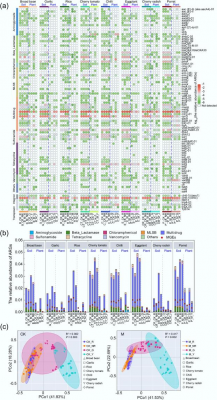Their study reveals that rhizosphere metabolites—substances secreted by plant roots—play a crucial role in regulating the distribution of manure-derived ARGs in both the soil and plant tissues. By investigating eight different crop species, the team found that while ARGs were enriched in rhizosphere soils, their presence in plant roots and edible parts was notably lower.
The spread of antibiotic resistance in soil-plant systems is accelerated by the widespread application of livestock manure, which serves as a conduit for antibiotic-resistant bacteria (ARB) and ARGs into agricultural soils. Although previous studies have documented ARG transmission from manure to plants, the role of plant-specific metabolites in mediating this process remains poorly understood. The rhizosphere plays a pivotal role in facilitating the transfer of ARGs from soil to plant roots and subsequently to edible plant parts, raising concerns over the potential risks to human health. This research aims to clarify the underlying mechanisms through which crop metabolites influence ARG distribution in soil-plant systems.
A study (DOI:10.48130/aee-0025-0005) published in Agricultural Ecology and Environment on 29 September 2025 by Fengxia Yang’s team, Ministry of Agriculture and Rural Affairs, Tianjin, sheds new light on the complex mechanisms by which plants and their associated microorganisms contribute to the migration of ARGs through the environment, offering important implications for food safety and public health.
A pot experiment was conducted across eight crop species to investigate the distribution of ARGs in rhizosphere and non-rhizosphere soils, as well as plant roots and edible parts. The study identified 81 subtypes of ARGs resistant to eight antibiotic classes, with multidrug resistance ARGs (MDR-ARGs) being the most abundant, followed by β-lactamase, sulfonamide, tetracycline, and MLSB ARGs. The total abundance of ARGs was significantly higher in rhizosphere soils than in non-rhizosphere soils, particularly in manured treatments. Crops like cherry radish and rice exhibited the highest increase in ARG abundance in rhizosphere soils, with an increase of 1.50 and 1.28 times, respectively, compared to unmanured soils. Interestingly, the diversity and abundance of ARGs decreased from plant roots to edible parts. For instance, in plants with edible leaves like porret, ARGs were more concentrated, while fruit-bearing crops like cherry tomato showed much lower ARG levels. The study also revealed that specific rhizosphere metabolites, such as lipids, significantly influenced the distribution and transmission of ARGs by affecting microbial interactions. Additionally, the study found that mobile genetic elements (MGEs) like cIntI-1 were closely correlated with ARG abundance, particularly in rhizosphere soils, indicating their role in facilitating the spread of resistance genes. A co-occurrence network analysis further highlighted how lipids in rhizosphere metabolites interacted with key bacterial species, influencing ARG transmission across different plant species. These findings underscore the role of rhizosphere metabolites in regulating ARG distribution and provide valuable insights for managing ARG risks in agricultural systems.
This study provides an important step towards understanding the complex interactions between crops, their rhizosphere metabolites, and the spread of antibiotic resistance. By understanding how different crops influence microbial communities in the rhizosphere, it is possible to identify crops that could serve as “biocontrol agents” to limit ARG accumulation in soils. Additionally, these findings could inform the development of agricultural policies aimed at reducing the risks of antibiotic resistance entering the food chain, thus safeguarding human health.
###
References
DOI
Original Source URL
https://doi.org/10.48130/aee-0025-0005
Funding Information
This study was financially supported by the National Natural Science Foundation of China (Grant Nos 42277033 and 42307543), Basic Research Foundation of Yunnan Province of China (Grant No. 202401AT070304), the Youth Innovation Program of the Chinese Academy of Agricultural Sciences (Grant No. Y2024QC28), Tianjin Municipal Natural Science Foundation (Grant No. 23JCYBJC00250), and Natural Science Foundation of Shandong Province (Grant No. ZR2023QD008).
About Agricultural Ecology and Environment
Agricultural Ecology and Environment is a multidisciplinary platform for communicating advances in fundamental and applied research on the agroecological environment, focusing on the interactions between agroecosystems and the environment. It is dedicated to advancing the understanding of the complex interactions between agricultural practices and ecological systems. The journal aims to provide a comprehensive and cutting-edge forum for researchers, practitioners, policymakers, and stakeholders from diverse fields such as agronomy, ecology, environmental science, soil science, and sustainable development.

